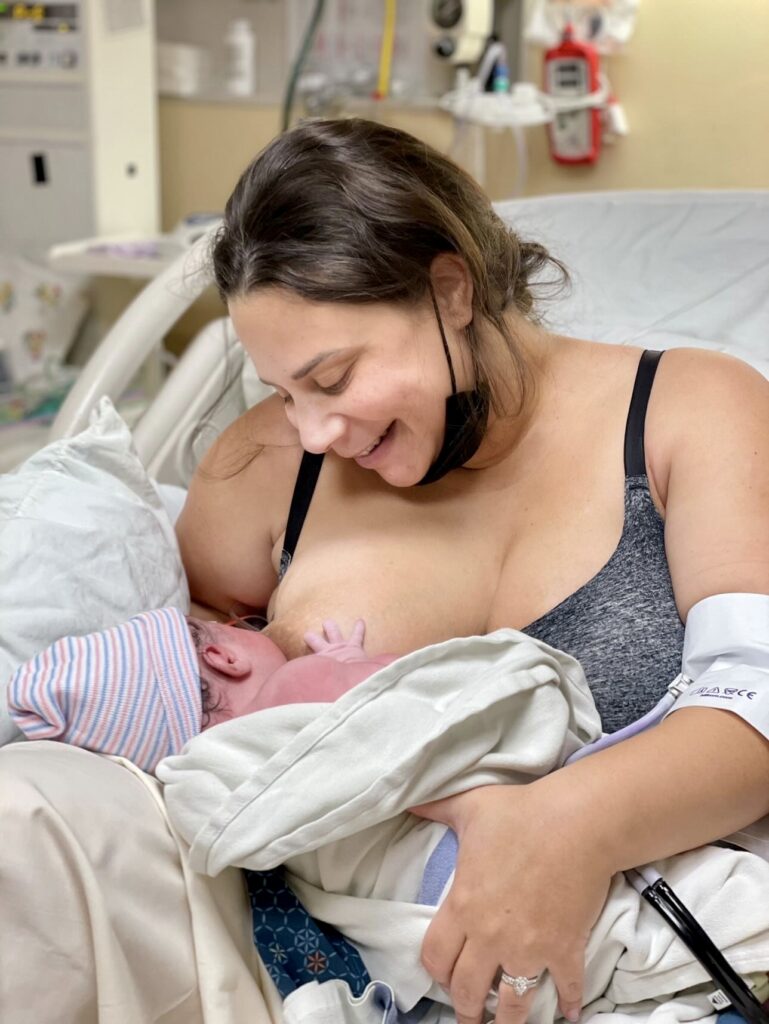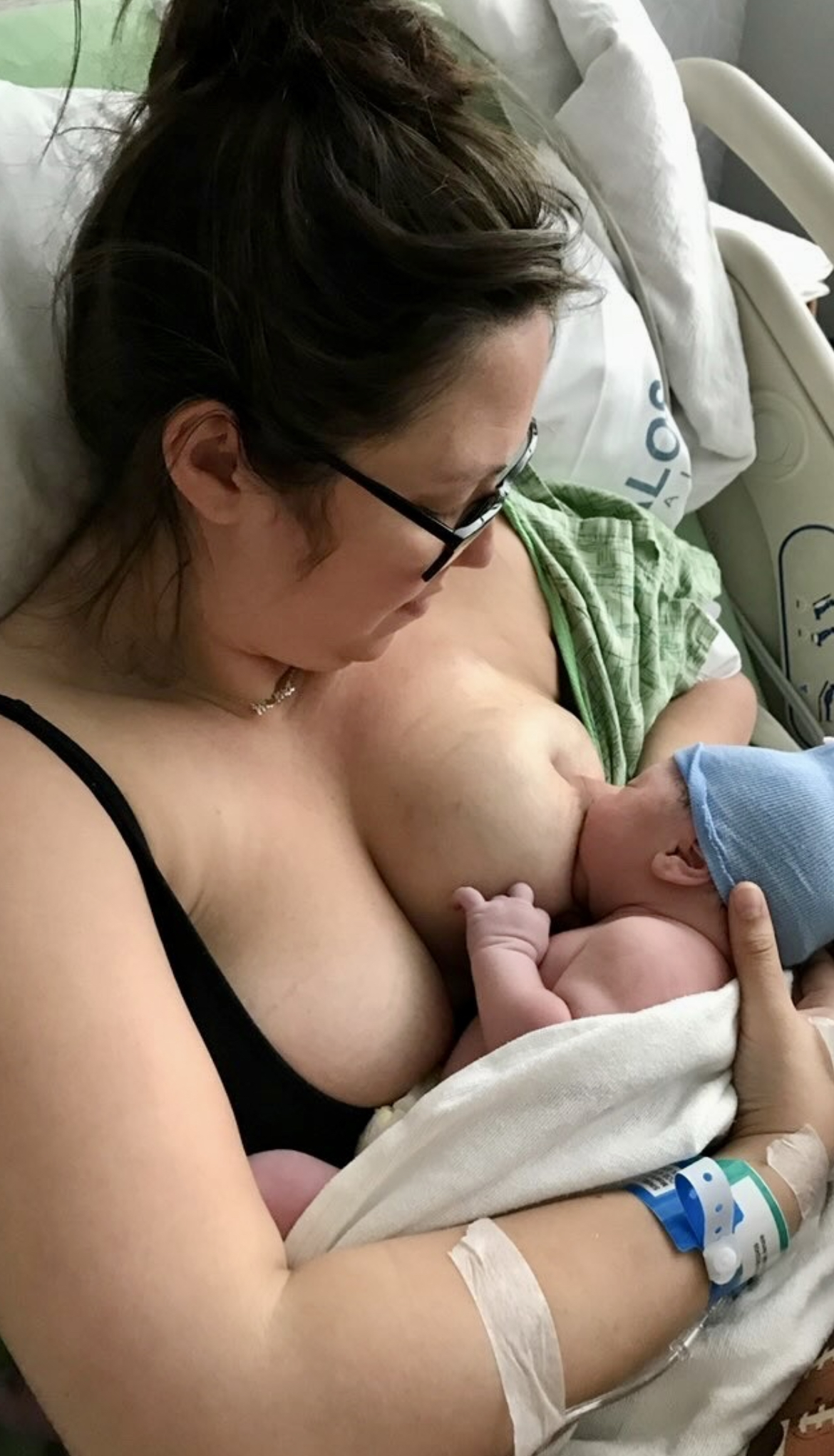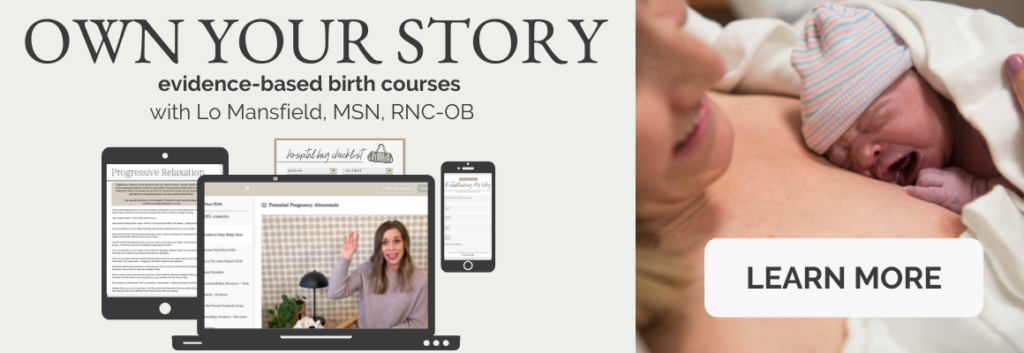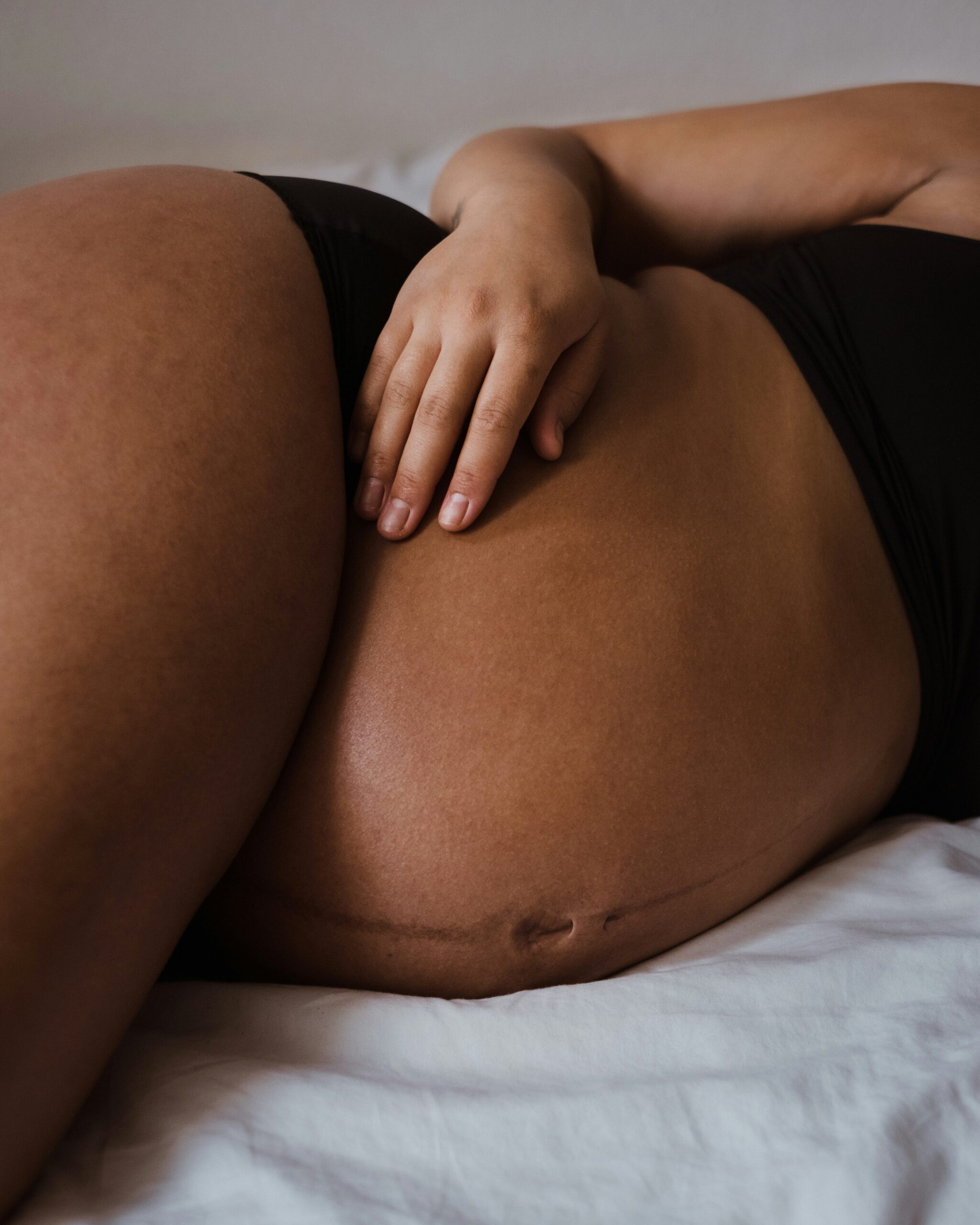Are you curious what happens after birth? I would be too! You have probably learned so much about labor, pain management, epidurals, or cesarean. But what happens now, when that is all behind you and that baby is on your chest? Let’s get into that together. These hours can be a whirlwind, and while I want you to get swept up in them, I don’t ever want you to not know what’s going on!
The fourth stage of labor
After the birth of your baby and your placenta, you move into the fourth stage of labor. This is commonly referred to as your “recovery” period. During this time, the ideal is that your baby is with you, skin to skin on your chest, and that you are both participating in The Golden Hour.
What is the golden hour?
The Golden Hour refers to 60 minutes of uninterrupted skin to skin that occurs between delivering mother and baby immediately after birth. This time is beneficial for baby’s transition, temperature regulation, bonding, and breastfeeding. During this hour, the first feed for baby will be done as well.
At most birthing facilities, your baby is under the care of a nursery RN during this time. Both that RN and your labor RN will be moving in and out of the room to keep an eye on both of you.

What happens after birth: for mom
Let’s go through a few different things to think about, for you, in the immediate hours after birth. This includes:
- Vital Signs/Fundal Massage
- Bleeding
- Treating Pain
- Getting Out of Bed
- Transitioning to Postpartum Care
Vital Signs and Fundal Massage
There are a lot of blood pressures and fundal massages done in thee first couple of hours. Many facilities are assessing these every 15 minutes or so until the recovery is complete. During a fundal massage, a care provider externally places a hand at the top of your uterus and massages (rubs down firmly). During the check, they are trying to make sure that your uterus is firm and that it is midline in your body, usually around the level of your belly button. They will also assess the bleeding that occurs as they massage.
Bleeding
You are expected to bleed and it may look like or feel like a lot. If a lot of clots are noted, the uterus gets soft, or the flow seems too heavy, your RN may ask you to try and empty your bladder. Those with an epidural may to be able to walk yet, so it is possible (though rare) that the RN needs to do a straight catheter. If an empty bladder doesn’t resolve any extra bleeding, it is also possible that they will want to administer IV or IM Pitocin (if you had denied it prior).
Postpartum Hemorrhage: If fundal massage and Pitocin administration do not help excessive bleeding, it is possible you may experience something called postpartum hemorrhage (PPH). Per ACOG, PPH is diagnosed when there is a blood loss >/= to 1000 ml during delivery, with additional signs of hypovolemia (low blood volume). PPH is one of the primary causes of maternality mortality, so this is a big reason management of bleeding is so important. It is also why your RN keeps rubbing on your uterus (sorry about that)!
Treating Pain
Pain can be a tough thing to think about – but we’re going to do it! For those with an epidural, you may feel pretty comfortable for a bit. As it wears off, you’ll likely start to notice any aches and pains related to tears and repairs. You can use an ice pack right away for the perineal area. Your RN can show you how to make them too! They usually feel pretty good throughout the first 24 hours or so on that sore perineum.
Your RN will probably have orders to offer you ibuprofen (which is okay for use now that you are not pregnant) and a stool softener. Starting on both of these early on may prove really valuable before you get up out of bed, use the restroom, and start the work of healing! For both myself and my patients, I’ve actually always been really surprised by just how helpful regular old ibuprofen can be!
Postpartum Cramping
Did you know? It’s pretty normal for uterine cramping to continue after birth – and it can be pretty uncomfortable! These are called ‘after-birth’ pains. They are a good thing, as it means your uterus is doing its job! Breastfeeding may increase this cramping as well. That is because it causes the release of oxytocin and that makes the uterus contract more. Typically, these pains are stronger with each baby as well. I didn’t notice them at all with my first – but with my second? They took my breath away! These pains can last up to about a week, but they usually peek in their intensity on day 2-3.
If you find your cramping pain (or any other pain) is just too much, speak with your RN! Hot pads might help. Don’t forget your breathing practices! Your RN can also let you know what else is available to you if you want something stronger.
Getting Out of Bed
When you get out of bed will depend a bit on you. Most stay in bed for at least the Golden Hour. Sometimes, those who deliver unmedicated may have to get up sooner to empty their bladder. If you get an epidural, you probably will need the full 1-2 hours before you gain full feeling back in your legs and can get up.
Your labor RN will have you up and to the restroom once before you officially become a “postpartum” patient. Do not get up without them! Regardless of any anesthesia medication you had, you just birthed a baby, lost some blood – you basically ran a marathon. It is not uncommon to feel a bit woozy or need a shoulder to lean on for a moment as you adjust to being on your legs again post birth. When you move or stand, you may also feel some blood trickle down your legs. This is pretty normal, even though it can feel or look like a lot. Once you get to the restroom, the hope is that you can empty that bladder. Check out this post for some tips and trick about that first (sometimes tricky) pee.
What happens after birth: for baby
What about all that’s going on for that new little life – your baby? Let’s go through some of what their RN is assessing and checking in on.
Apgar Scores
Right at the moment of birth, your care providers will assign an Apgar score to your baby. These scores are given at 1-minute of life and at 5-minutes of life. If the 5 minute Apgar score is lower than preferred – usually 7 or above, your baby will likely continue to be scored in 5 minute increments.
The Apgar score is made up of 5 different categories: baby’s appearance (color), pulse rate, grimace (which means their reflexes), activity (which is about their muscle tone), and their respiration rate/patterns (which is their breathing). Each of these categories is given a score of 0, 1, or 2. A “perfect” Apgar is a 10 – however, I rarely saw those given! Typically, all babies lose a point or 2 for color. This is because it is really normal for them to have something called acrocyanosis, which causes blue hands and feet.
The First Feed After Birth
If you are hoping to breastfeed, the first attempt(s) happen during this first hour or two before your transition to postpartum care. Both your RN and baby’s RN are there to help you with this! I want you to remember that as much as this is a “natural” process, both you and the baby still have a lot of learning to do. Be gracious to them and yourself – and please, take the resources and help that your birth facility can offer!
At this point, your breasts are expressing colostrum. It is a thick, gold-ish colored fluid. It is small in volume, but really high in benefit! You may have leaked colostrum during the end of your pregnancy. Some also choose to do antenatal hand expression of colostrum during their pregnancies too. If that interests you, please speak to your provider about it!

Here are some benefits of colostrum:
- It’s packed with nutrients and antibodies
- It’s small volume is actually the perfect amount for their tiny stomach
- It supports baby’s immune system
- It helps baby pass first stools
- It can reduce the risk of jaundice
- It seals and protects baby’s gut
One of the most common questions I get from my postpartum patients during these first feeds is “Are they even getting anything?” And the answer is “yes!” – they are getting that colostrum. While it doesn’t seem like much, their stomachs are very small at this stage, about the size of a marble or cherry. Throughout the first week, your body will begin producing transitional milk as well, and then eventually, mature milk. When these changes occur, the volume of milk will slowly increase, and their stomachs grow too!
Newborn Assessments + Measurements
So, what happens when skin-to-skin is over? When you’re ready, your baby will likely be taken to the warmer in the room for a full head-to-toe assessment, measurements, and the administration of any newborn medications. During the head-to-toe assessment, an RN checks your baby from top to bottom. This is not just an external exam – they’ll also be able to check ears, eyes, inside the mouth and palate, and reflexes. This initial assessment can be quick – the RNs are well versed on what to look for – but it is also really important, because it becomes the baseline assessment for which the team can compare any changes to moving forward! This is a cool resource about what is being assessed.
For more on recommended newborn medications and vaccine: Vitamin K, Erythromycin Ointment, Hep B Vaccine
Measurements
Alright, I know that the first question from many family and friends is “how much did the baby weigh?” Remember – as fun as it is to know – this CAN wait until after skin-to-skin. But now is the time to find out! The baby will get their first weight – don’t forget to grab the camera! – and the nurse will also measure their head circumference, their abdominal circumference, and their length. Many facilities will write all of these details on some sort of ID card and you can refer back to it as you share with those curious family and friends.
Still need a birth plan that details all of these tips and choices? I’d love to send you mine. Get it here.
Transitioning to Postpartum Care
After these first couple of hours, most mama/baby couplets become “postpartum patients.” If you delivered in an LDRP unit (like the one I learned at!) your bed was remade while you were in the restroom. You simply crawl back into that fresh bed and settle in for postpartum care. Your RN might change at this point – but many are actually trained to do everything, so they may keep caring for you and your baby during postpartum too.
If you deliver at a hospital with separate labor and postpartum units, you’ll be transported to your postpartum room. Your partner can bring along all of your things as well. And most of the time? Baby is coming with you!
The takeaway on what happens after birth
There is so much crammed into these couple hours after birth! Hopefully, your baby can be on your chest and you can be blissfully unaware while the nurses around you do their jobs. A gentle reminder to speak up and ask questions anytime you want. I want you to trust your team to do their jobs, but also? This is your body and your baby, so don’t hesitate to say “hey, what are you checking out?” if you are ever curious!





